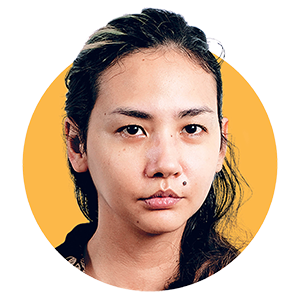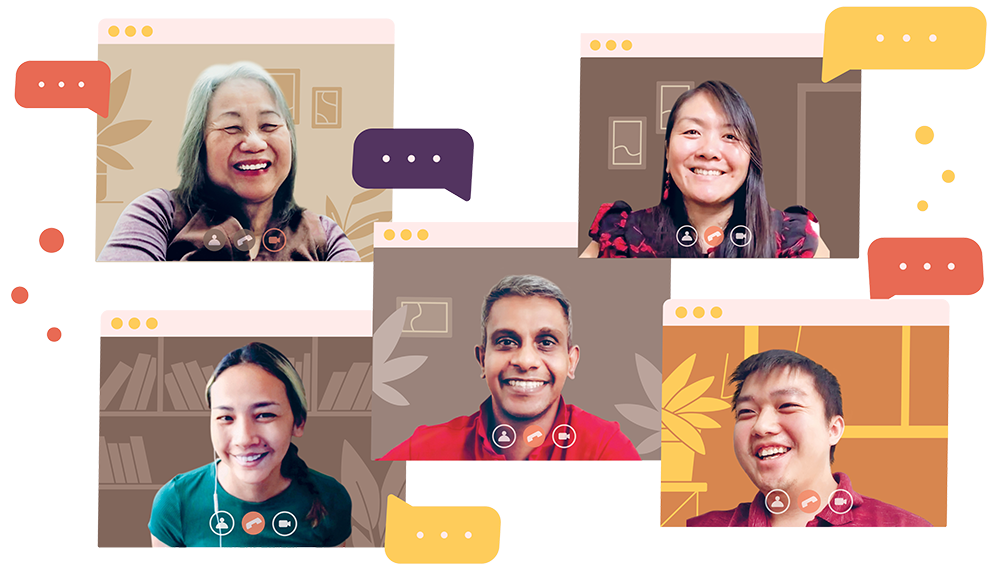Regarding ‘Regardless Of Race’
How do we build a truly integrated, multiracial and multicultural society? Should ethnicity even matter in Singapore society? Are our differences a cause for celebration or division? Our alumni tackle these questions and more.
One United People?
While Singapore is often held up as an example of racial and religious harmony, what do these terms translate to in practice? Also, a number of talking points in recent years — migration, xenophobia, ‘Chinese privilege’ and incidents of racial insensitivity — have challenged this narrative, and opened up a debate on how far we have actually come, and where indeed we wish to head to as a society. Our alumni share their thoughts.
OUR PANEL

Ms Sui Chin Han-McKeand
(Law ’76)
Retired Lawyer

Ms Jennifer Anne Champion
(Arts and Social Sciences ’13)
Poet and Educator

Mr Adrian Purnama Phoen
(Arts and Social Sciences ’17)
Financial Planner

Mr Navin Lobo
(Law ’03)
Lawyer

Mrs Angeline Lobo
(Arts and Social Sciences ’04)
Civil Servant, Working in International Relations
The Chinese-Malay-Indian-Others (CMIO) framework is unique to Singapore, and a powerful public policy tool. Do you think this model is still relevant today, given how Singaporean society has evolved to include more mixed-race individuals, and new citizens of different ethnicities?
Jennifer: There is a difference between being relevant and being accurate. For somebody like
me, whose father was born into two cultures and myself into four, it was never accurate — and it wouldn’t be for an increasing number of mixed-race Singaporeans. My identity card says that I am Ceylonese Tamil, but I don’t really have any connection with my Tamil roots and am much closer to my Chinese and Malay heritage.
Navin: I hear Jennifer’s point on accuracy. As parents of mixed-race children, [Angeline and I] see the limitations of the CMIO system first-hand. What matters, too, are the policies that the framework translates into, such as mother tongue education and housing quotas.
Sui Chin: I have lived in the United Kingdom and Japan, and have been out of Singapore for more than 35 years. At Narita Airport in Tokyo, you see the categorisation of ‘Japanese’, ‘European people’, and ‘aliens’. Am I an alien? Similarly, I have issues with the term ‘Others’ — which seems very excluded and non-definable. It is almost like being marginalised. Yet in today’s context, the margin is slowly becoming a full page, because if we were to trace our ancestry, few of us would be of one pure heritage. For example, I have 25 per cent Dayak blood: so am I Chinese? Why not just call ourselves Singaporeans? It doesn’t matter what race you are, but allow the national identity to dominate.
Adrian: In Indonesia, where my family was from, there isn’t a CMIO system, but you still see differences between Indonesian Chinese and Indonesian Malays — and the differences become a barrier to interaction. It’s not a matter of frameworks or systems, but a matter of a willingness to connect with others of different backgrounds. This interaction is what the world needs.
Should we do away with the framework altogether? Or can it be effective in promoting integration, such as through ensuring mixed-race environments in schools and public housing estates?
Adrian: Growing up, I didn’t really see much sharing between the different races. Racial Harmony Day in school was just a day for dressing up, rather than actually learning anything about the different cultures. There was a general lack of initiative from the kids to make friends outside of their racial group, or to learn about other races. Now that I am in the workforce, I have also encountered clients who prefer to be serviced by those of their same race, as they feel that there might be a better common understanding. So while I did not feel any negative impact from the CMIO framework — being of the majority group — I did not observe how the model promoted integration.
Jennifer: As a person who would benefit from the CMIO model being thrown out, I actually think it is still relevant. I am willing to forgo the accuracy for the relevancy for others, because we can’t truly be race-blind. If we were to find a way to be accurate about who I am as a person, we would be going into finer and finer gradations — at some point it would be madness. But for those who fit into the categories squarely, the model offers a concreteness of their identity and the community that they belong to. Thus I see relevance for them, and I think that is important, which is why even though the model is problematic, it cannot completely disappear.
Sui Chin: It is a useful measure and has its purpose of promoting racial integration, which the government put effort into after the race riots in 1964. Minister for Home Affairs and Minister for Law, Mr K Shanmugam (Law ’84) once mentioned how Singapore has been successful in promoting ethnic integration in our public housing estates, schools, and via National Service. The CMIO model has its purpose and value but it can also be abused — we just have to be aware of how we use it. So while the cultural integration it creates is artificial, I do see its efficacy.
Angeline: I see myself more as a Singaporean than a Chinese person. I see greater differences between myself and a Chinese person born in China, than with a Singaporean of another race. The common experiences we share — be it through the public education system or just growing up in the same environment — build a stronger national identity than a racial identity for me. That said, it is difficult to have true cohesion. We have housing and education policies that try to promote racial and cultural integration based on the CMIO model. But as society progresses and becomes more complex, a lot of policies will not be accepted so simply by the people. Integration is something that cannot be forced upon people: it has to start from the ground-up, rather than come from top-down directives. It is for the people themselves to examine why it is important to have cross-cultural interaction.
Have you personally experienced or observed racial prejudice? Do you observe racial prejudice as getting better or worse within the country?
While an acceptance of cultural differences is what we work towards, we are only at the stage of tolerance. What we can strive towards — at least on an institutional level, and in the media — is to make sure that sensitivities are not offended.
Mr Navin Lobo
Jennifer: As a Primary 1 student, I was very confused about what traditional costume to wear. My teacher very thoughtfully suggested that since I am ‘Eurasian’ — though I am not — I could wear Dutch Eurasian clogs. I didn’t quite understand — and brought a clock to school instead! That was just a funny episode, but it goes to illustrate that things like traditional costumes and food are only superficial cultural markers, rather than a person’s identity or what shapes them. And as Angeline said, true integration starts at home, in places where the government cannot reach. How willing are we to have this conversation among ourselves?
Navin: Personally, I am often spoken to in Tamil, even though I do not speak any Indian language at all. While it doesn’t bother me, I have friends who would get upset over this. The reality is, how people react is a product of their life experiences. If you get upset over an act done without malice, you might also reflect on why you react this way. That said, I still hear people cracking turban jokes whenever they see a Sikh man. Such behaviour is silly and hurtful, yet it is pretty impossible to have a utopia without race or religious issues. While an acceptance of cultural differences is what we work towards, we are only at the stage of tolerance. What we can strive towards — at least on an institutional level, and in the media — is to make sure that sensitivities are not offended. This doesn’t mean taking away the cultural aspect of society altogether: if we do that, are we not going to celebrate Chinese New Year? Are we not going to have Deepavali? Racial and religious inclusiveness is something Singapore takes pride in, but it takes just one misstep to undo years of work.
Angeline: I do observe that the younger generation are more open about mixing with children of different racial backgrounds. My daughter just started Primary 1 and her closest friends are a Malay girl and a classmate from China. At their age, they don’t see others as conforming to stereotypes — a lot of times it is we as a society who pile our own prejudgements on them and influence their worldviews.

SO SAY THE PEOPLE
According to the Institute of Policy Studies (IPS)-OnePeople.sg survey on racial and religious harmony in July 2019, almost 60% of Malays and 56% of Indians in Singapore perceived discriminatory treatment at work.
In an IPS Working Paper published in October 2019 that surveyed 4,000 respondents, almost
three out of four respondents agreed to varying degrees that they like meeting and getting to know people who have recently migrated to Singapore.
However,
more than 70% also felt, to varying degrees, that immigrants are not doing enough to integrate into Singapore.
Do you think there are cases where members of the minority groups are being overly sensitive?
Jennifer: There are some minorities who feel sensitive because these microaggressions do accumulate. Once, I was taking an Uber Pool home and the driver looked at my name and deduced that I “must be Eurasian”, and he and the other male passenger — who was a complete stranger to me — decided that I must be very pretty and that they needed to turn on the lights to see my face. It wasn’t just an incident of racist and sexist typecasting. But at that point I was focused solely on getting home safely, rather than speaking out. It is one thing to say that one should be courageous and brave, but you might not feel safe to do so. And there isn’t a lot of education on how to express what’s hurting you, or empowering minority groups with the fortitude and mental support to speak up for themselves. That said, there are groups out there that facilitate this, such as
Minority Voices, which crowd-sources stories from those of minority backgrounds. It’s a good resource for people to find ways to express what they are feeling. I like that young people are stepping up and speaking out.
Navin: I recently offered to handle a pro bono case, where the clients were discriminated against because of their race: they were looking for a rental property and were turned down the moment the landlord learnt their racial background. We claim to be a tolerant multiracial society, but there are lots of things that we need to be better at solving, that we have to be empowered to speak about, because things can change. When there are so many microaggressions happening for so long and so often, some might think: “I am not going to talk about it, because nothing will change.” Yet such situations do need to be addressed. Change is a process. We might not be progressing as fast as we should, but I do feel that we are moving in the right direction.
Sui Chin: Racial typecasting happens all around the world: I am often identified as the maid to my Eurasian-looking children, at my very own doorstep no less. While I was working as a bank lawyer, I would often find myself the only woman in a roomful of Caucasian men — and my peers would often be surprised when I expressed my opinion. Having lived that kind of ‘dismissed identity’ — even within my immediate English family — I have learnt to use humour to temper the negativity. Once you are proud and secure of your own identity, nothing can touch you. And the huge, humbling process of living abroad strengthened and made me proud of my identity, particularly as a Singaporean.
On that: do you think a strong nationalistic identity could prevent our acceptance of new citizens, and the influx of foreigners?
Welcoming foreigners into our country also gives us a very cosmopolitan society with a wide cross-section of people of different backgrounds: it puts us in the best position to understand the world. I believe Singapore represents what the ideal world should be.
Ms Sui Chin Han-McKeand
Jennifer: In 2017, I was at the airport waiting for my partner when a Singaporean man beside me started shouting at a Filipino family, first saying that “This is Singapore” and that they were not allowed to hug, and then telling them to go back to their home country. I stood up to him and told him that I am Singaporean and did not approve of what he did, and wrote my thoughts on the encounter (with regards to racism, class privilege, and bigotry) and
shared them on Facebook. The post went viral and was even picked up by the local media. The best part of it was that the family found a way to contact me through the news article. They reached out saying that they were okay, and happy that their first impression of Singapore was of people who would stand up for them.
Adrian: We do hear a lot of Singaporeans complaining about expats, but it doesn’t have so much to do with cultural differences than the competition for jobs and housing. I think a big part of it also depends on the new citizens’ willingness to be integrated into our society. Some come over in their late 30s and 40s, with very different backgrounds, memories and expectations that were born out of their life experiences, and might be unwilling to adapt.
Navin: If you look at what has happened in the last five years, it is quite clear that the huge influx of expats has caused some frustration and discomfort on the ground. But is it because we are xenophobic? I sense a lot of frustration is due to the fact that the development of our infrastructure hasn’t caught up with our already-dense population — so you have young couples having to queue for housing, graduates finding it hard to find a job, etc. And when you are frustrated, you look for something or somebody to blame, so expats became an easy target.
Sui Chin: I see a lot of people who use Singapore as a springboard or stepping stone. But Singapore has always played the global role of an entrepot, and I feel we can continue to welcome foreigners in this manner: as a place to raise children, to start a business, to progress in life before you move on to some other place. To me, that is good enough because we have played our role in the world. It gives them an experience of Singapore as a place of opportunity that has benefitted them. If we give them opportunities that they will never forget, when we eventually do business with them, these memories will inspire the same kind of gratitude. Welcoming foreigners into our country also gives us a very cosmopolitan society with a wide cross-section of people of different backgrounds: it puts us in the best position to understand the world. I believe Singapore represents what the ideal world should be.